|
|
Sunday, April 19th, 2009 at 11:43 am
I shared this story about our chickens with a few friends the other day. You see, we got home from our Semana Santa trip (still working on that post), and had dinner with our family. We asked them how our chickens were doing and they told us they were dead, hahaha. Everyone in the room smiled and laughed. That’s our host family, very sarcastic. 🙂 Our chickens were alive and well since they take good care of everything for us.
Lina asked us, “Who’d you buy the chickens from?” We told her the name of our chicken vendor, who we know is also a family cousin that lives up the road. “Ahhh,” Lina said, working something out in her head. “Well, while you were gone your chicken spent a lot of time at Manuel and Lina’s house (the notorious Manuel with a wife of the same name as our story teller), and she says your chicken is actually hers that was stollen a few days before you two got your chickens.” I felt a litte sad about this, like someone was going to try and reposses one of our chickens after we’d spent some time taking care of them and getting them used to living with us. “She says she knows her chicks and that one is definitely hers.” So I explained to Lina, that it could be possible, but we’d paid for these chickens when they were just chicks and had waited a month before collecting them, so I didn’t really think they were stolen. “Well it could be that someone stole her chicken and sold it to Maria who sold it to you and no one even knew it was stolen.” I told her, yes, that was possible, but probably the best way for this to be worked out was for Lina to talk directly to Maria, as the two of them could communicate better without Jaime and me in the middle. They all agreed that sounded reasonable, and we left it at that.
Ladrones are always a problem here, that is, thieves. About a month ago an ax we’d been using to chop firewood and leaving outside our house disappeared. The family asked us to be more careful about using their tools and storing them when we were done because ladrones always take things around here. We felt a little bad about being irresponsible with their things. Our host family eats in shifts so that someone is always on this side of the cornfield near our house and the house where most the family sleeps in case any ladrones should show up. The kitchen and sink for clothes and dish washing are just through the cornfield a ways, but a ladron could slip in and out unnoticed if we left things unattended. While constructing the greenhouse we were again reminded to store the tools in our house for as long as we needed to use them so no one stole them. There is a big fear around here of the damage a ladron can do.
So today, Fletch walked in the house laughing, “Well, we solved some ladrones mysteries this morning. One, the ax that disappeared last month, they found it on the roof of the house. Nas put it there for some reason and forgot about it; nobody else knew where it was until they found it on accident today. And Lina’s chicken, found dead smashed under a beam in Petrona’s new house. Mystery solved.” Note: Petrona’s house is still under construction, so no people have been hurt by falling beams. We thought maybe these ladrones claims were largely exaggerated, but took measures in part erring on the side of caution and in part so the family would not tell us a million times more about ladrones.
I’ve had the feeling people are often their own ladrones, but they’ve got so little they really don’t like losing things. Maybe ladrones is another example of evading personal responsibility, which we’ve mentioned before? Maybe, maybe not. Today we just feel a little vindicated, and ain’t nobody takin’ our chickens. I just hope ours stay out of the way of falling beams.
Posted by: emily
Saturday, April 18th, 2009 at 12:59 pm
So some of you know that we live across the valley from a town called San Sebastian. What’s interesting about San Sebastian is that about 200 people from this particular town now reside in my home town of Logansport, Indiana and attend All Saints Church, the school and church I went to growing up.
At the moment, I’m sitting in our little clubhouse and the radio at the neighbor’s is blasting, as per usual. A birthday wish is going out from Logansport, Indiana to San Sebastian for a little girl, Gladys Inaida; I don’t know if the little girl is here or there. HAHAHAHA. Life is so weird. That’s my home town on the radio! They just keep saying, “Logansport, Indiana….Logansport, Indiana.”
And now we sing a song from a favorite childhood record: “It’s a small world after all. It’s a small world after all. It’s a small world after all. It’s a small, small world.” Indeed, it is.
Posted by: emily
Friday, April 17th, 2009 at 8:01 pm
 Great news! We’ve had our first success with chickens. Since all the neighborhood chickens are free-range, we had to take steps against our new chickens deciding to join a diffferent flock. Following our neighbors’ advice, during the day we tied our chickens to a stake near their coop with a 20′ string around their leg. At night, we locked them in the coop with some food and water. The idea is that after a week, the chickens forget that they ever lived anywhere else. Today was the big test: in the morning, I opend the coop door and watched them streak out of there and disappear into the horizon. I felt kindof like I’d been tricked. This evening, Emily and I waited patiently for their return. OK, that’s a lie. I harrassed Emily to go find them, and Lina told her that it was pointless and we just had to wait. Great news! We’ve had our first success with chickens. Since all the neighborhood chickens are free-range, we had to take steps against our new chickens deciding to join a diffferent flock. Following our neighbors’ advice, during the day we tied our chickens to a stake near their coop with a 20′ string around their leg. At night, we locked them in the coop with some food and water. The idea is that after a week, the chickens forget that they ever lived anywhere else. Today was the big test: in the morning, I opend the coop door and watched them streak out of there and disappear into the horizon. I felt kindof like I’d been tricked. This evening, Emily and I waited patiently for their return. OK, that’s a lie. I harrassed Emily to go find them, and Lina told her that it was pointless and we just had to wait.
We then were invited to dinner, and didn’t notice the passing of day into night. When we got back home, Emily sent me down to the coop with a flashlight, and Lo and Behold! there were the chickens, looking kindof nervous that a predator such as myself might be eyeing them so closely. I closed their little door, and returned to our house. We now officially have Free Range Chickens. Yay! Now we just have to wait for some eggs to appear.
Posted by: jfanjoy
Friday, April 17th, 2009 at 1:19 pm
We’re going to backtrack and update you all on our busy last week, but I need to post this update of the last few days first. You see, we’ve been noting the ebb and flow, the day to day feeling of how much we “get it” here. That is to say, some days something will happen and we’ll think, “Aha, I get it,” until two days later something happens to remind us, “No, we are still outsiders. We still don’t get this place at all.” It’s a pendulous existence between really great days and really less than great days, which isn’t too different from normal life except that all of our senses are heightened, so it’s great and really less than great on steriods. Anyway, here’s my story.
We’ve been out of site a lot, as we went to Antigua for Semana Santa (and the post on that is coming, so anticipate…). We got super lucky, as our boss scheduled to visit our remote work site, Quixabaj, this past Tuesday. For him, it’s a days drive to get all the way up here, which meant he had to leave on Monday, which also meant he drove us home. YAY! We got a late start, and arrived in the village even later, at about 9pm (but the computer center is now underway! More on Fletch’s wall). We had time to unpack from the days past and repack for the annual department-wide security meeting, which we’d be leaving to attend right after our little jaunt to Quixabaj. That required us to leave town on the 6:15 micro the next morning.
We definitely feel like we’ve been out of site too much, but we try to keep checking in with the family always. I hollered through the window right outside our house into Reina’s room to say we’d come home and that we were off again until Thursday early tomorrow morning. She and I always keep in touch. I like her a lot; in fact, I’d say she’s probably the closest Guatemalan friend I’ve got. She hollered back, and we all went to bed.
We’ve been working on getting this other village, even farther out in the middle of nowhere and even poorer than where we live, its own volunteers. It was apparent in our first visit there that we’d be unable to give this community the attention and support it deserves, and since then we’ve been petitioning our boss to place volunteers from the incoming group in this site. Our boss is a good sport, and since we wouldn’t shut up about this village, he made the effort to come see it and bring our security director with him to see if they could approve the site for future volunteers. We were really excited about this. Our health technician, who is our local supervisor, and Manuel, our village health comittee president, and Don Tomas, another local leader, all came with us. We were in the middle of what was a pretty productive meeting between our posse and the community leaders when I received a text message from Reina.
She said, “Hey, where are you? I wanted to let you know I have a new baby.” At first I thought, what? Then I thought, haha, she’s joking, but what is she actually talking about? And then I was just really confused. I sent her a joking message asking her where she got her new baby and what she did with her old one, haha. She sent me this message: “I was pregnant, and the baby was born today, and it’s boy.” Reina is really sarcastic, and really good at carrying on dead-pan jokes like this, so I just sent her a message asking, “Are you serious?” And I was confused some more while we waited for the next message to come in.
You see, a few days before we left for our Semana Santa vacation I was hanging out with Reina at the pila, washing clothes. For some reason she hadn’t gone to work in like 2 weeks, which was very unlike her, but she just said it was because no one was around to take care of her daughter. She’s between care-takers, but that doesn’t usually stop her since she has 4 sisters at home that take care of Delmy for her any time she needs it. I was washing clothes and looking at her and something about her posture struck me. I thought she looked a little pregnant. I told Fletch as much, but when I say a little I mean like 4 or 5 months. I’ve seen a lot of pregnant bellies in my life. My first thought was, “Hey, maybe I can be there for the birth? I’ve never seen one, and that would be cool.” But I figured I was probably just imagining it, or she’d tell me if she was pregnant when she felt she should.
As you might imagine this added greatly to my confusion. Was this real, or an April fools joke with Guatemalan timing? It didn’t help that Reina never answered my last text message to confirm. The road back to town from the village is a 2 hour ride which gave me lots of time to mull over my thoughts: We’ve lived here for almost 9 months exactly, so providing this supposed baby wasn’t early, she’s been pregnant the whole time! Why wouldn’t she have told me; I thought we were friends? I know that the Q’anjob’al word for a pregnant woman is yob’ ix but I never heard anyone in the family use it? This is SO Guatemalan of the family to not tell us this very obvious thing, that a baby is coming. Is it a Mayan cultural thing that they don’t talk about the baby at all until it’s here? I sleep ten feet from this woman, how could I not have known she was pregnant at all!? Is this for real, seriously? If she really was pregnant and really did have the baby, then I missed my opportunity to see the birth. Bummer.
I really wanted to go all the way home and check it out, you know, see if there was a baby, but we had to go on to the state capital for the all-day meeting the following day, and the meeting was to run too late for us to make it back that night. Thus I was left to wonder some more. In spite of meeting up with and hanging out with lots of fun volunteers, every once in a while I would wonder about this situation. Though I was becoming more and more convinced that it was not a joke, I needed to see it to believe it. I sent her a text message with the plans of our arrival home and asked her if the baby had a name yet. She wrote back saying they were thinking they’d call him Nas, like her Dad. That would make him the 4th Nas, as two of his other grandchildren (Galindo and Chalio are nicknames for the other Nases) are named after him as well. It was sounding pretty real to me.
So this morning we got on the bus to come home, and I was anxious to solve the mystery. I began cataloging my questions for Reina, figuring out the proper words and order for asking them. We arrived in town and caught the bus to our village directly. On the way I started a conversation with the woman next to me, who I didn’t remember ever seeing before. She didn’t know who we were either, which was definitely strange. We talked for awhile, and as we got closer to home she leaned over and said, “A woman in town died today from child birth.” Suddenly I was really afraid, and Fletch hadn’t heard the name the woman said so we asked her again. The woman’s name was Maria.
We pulled up to our stop, the last one on the bus route, and hauled our things up to the house. Naturally, I dropped my bags and went in search of a baby. And sure enough, Reina was resting over at the other house with her new little boy. She let me hold him and we started talking.
The first thing I asked was, “We’ve lived here for nine months next week, that means you were pregnant this whole time?” I said sort of laughing in surprise. The answer was kind of obvious, but she shook her head yes  and smiled, embarrassed. So I asked why she didn’t say anything about it advance. This is where things got interesting. She didn’t tell ANYONE in the family she was expecting a baby, NO ONE. She shares a bed with her 17 year old sister, and her sister didn’t even know. So this is not a Mayan cultural thing. She’s a single mom, pregnant with her second child, and she was afraid of what her parents would say. She couldn’t do anything about being pregnant, nor could they, so she just didn’t tell them. “They might have guessed, but they never said anything to me either,” she said, “I thought about telling you a few times, but then I was always too embarrassed to say anything.” I told her not to worry about that in the future; I’m alright at keeping secrets. She laughed. Then I said, “So we left here at 6:15 in the morning, and you told me you had a baby around 12, when did you go into labor?” Her labor started early in the morning, but it wasn’t too bad. She didn’t get out of bed until 8, which is normal for her on days she doesn’t work. Her parents were leaving to go a family wedding, and she thought about telling them she was in labor (mind you they didn’t officially know she was pregnant), but decided not to. They left, and she told her sister Masha, who was the only one at home to help her, that she was in labor. The midwife was at the family wedding as well (maybe she should have mentioned something to her parents beforehand, after all). So Masha, who’s given birth to 5 children and is raising the only one who made it through birth alive, ran to get their neighbor/cousin Petrona, who is a mother of 8. Together Masha and Petrona delivered Reina’s baby. She said her water broke a little around 8:30 and Nas was born about 20 minutes later. Her parents came home from the wedding to a new grandchild–no use getting really mad then! Though I think their feelings are a little hurt, based on our exchanges today. That would be understandable. She told me she wasn’t sure if she should have sent the text message when she did, but I told her I was glad she did. I told her that I’d mentioned to Fletch I thought she looked pregnant, but not full term, and that in thinking back I realized she wore a lot of bulky sweaters. She laughed. and smiled, embarrassed. So I asked why she didn’t say anything about it advance. This is where things got interesting. She didn’t tell ANYONE in the family she was expecting a baby, NO ONE. She shares a bed with her 17 year old sister, and her sister didn’t even know. So this is not a Mayan cultural thing. She’s a single mom, pregnant with her second child, and she was afraid of what her parents would say. She couldn’t do anything about being pregnant, nor could they, so she just didn’t tell them. “They might have guessed, but they never said anything to me either,” she said, “I thought about telling you a few times, but then I was always too embarrassed to say anything.” I told her not to worry about that in the future; I’m alright at keeping secrets. She laughed. Then I said, “So we left here at 6:15 in the morning, and you told me you had a baby around 12, when did you go into labor?” Her labor started early in the morning, but it wasn’t too bad. She didn’t get out of bed until 8, which is normal for her on days she doesn’t work. Her parents were leaving to go a family wedding, and she thought about telling them she was in labor (mind you they didn’t officially know she was pregnant), but decided not to. They left, and she told her sister Masha, who was the only one at home to help her, that she was in labor. The midwife was at the family wedding as well (maybe she should have mentioned something to her parents beforehand, after all). So Masha, who’s given birth to 5 children and is raising the only one who made it through birth alive, ran to get their neighbor/cousin Petrona, who is a mother of 8. Together Masha and Petrona delivered Reina’s baby. She said her water broke a little around 8:30 and Nas was born about 20 minutes later. Her parents came home from the wedding to a new grandchild–no use getting really mad then! Though I think their feelings are a little hurt, based on our exchanges today. That would be understandable. She told me she wasn’t sure if she should have sent the text message when she did, but I told her I was glad she did. I told her that I’d mentioned to Fletch I thought she looked pregnant, but not full term, and that in thinking back I realized she wore a lot of bulky sweaters. She laughed.
I have a lot of mixed feelings about this. It sounds so irresponsible that she didn’t tell anyone! But she is a nurse’s assistant. She went to the doctor for regular check-ups, which much more than most people here do, and even knew she was having a boy because she had an ultrasound done. She laughed that Nas was wearing Delmy’s old baby clothes because she couldn’t buy boy baby clothes or someone would have found out. I also think her situation is a testament to the necessity of teaching EVERYONE about birth and warning signs, because with only 1 or 2 midwives in town sometimes they aren’t around when they’re needed. Completely untrained people, who lack knowledge of basic hygiene practices like hand washing, are DELIVERING BABIES! I also felt sad for Reina that she went through the whole pregnancy pretty much alone. She told me her babies have the same father, and I’ve known for months they weren’t together anymore. However, she did tell the local nurse who ran into her at a check up once, and the local nurse is one of our favorite people, and herself a single mom. I’m glad she at least had that support. I just kept thinking, all of these complicated social issues on top of the fact that she had her baby with absolutely no medicine or medical attention save her own, in an adobe house with dirt floors. It was one of those moments I thought, “Oh my god, we Americans are such wimps.” Deliveries bring to mind moaning women, sometimes screaming. She shared a bed with her little sister for hours while she was in labor and didn’t mention to anyone she was having a baby until just before her water broke.
In my mind I have a picture of what happened at the birth. In it, Reina is stoically working her way through contractions and telling Masha and Petrona what they need to do to get ready, doing everything short of reaching down and catching the baby herself. Knowing her, it seems probable.
Just as we were winding down our conversation she received a call. She told me the call was pertaining to a woman who had died today in childbirth. I told her we heard in the microbus, but then she told me the woman was a cousin of the family. Everyone was getting ready to go to the wake. We said our goodbyes. Just as I got home, was looking out the window, and a truck with a casket in the back drove up the road with three full micro-buses following behind. They stopped in front of our house, and everyone told us to come along with them. We made up some excuses to not have to get in a crowded bus again today, assuring them we’d be along soon. As they loaded up and left for the house we talked about whether or not we should show up, whether it would be appropriate. Thinking back on the Galindo experience, we decided that since their illness and death customs here are community centered it would probably be appropriate for us to go. We didn’t particularly want to, but thought it best to show our support for an extended member of our host-family here, thus we took off up the road on foot.
We knew which house was hers because all the vehicles were parked outside. We walked up to the back door where half our health talk attendees had fires going all around them, huge pots of boiling water atop them, and a table with an enormous mound of tortilla masa being scooped out and shaped by 20 some hands, wrapped in leaves for tamales and carted around the house to another fire where there was the biggest of all pots for cooking the tamales. The women seemed generally happy to see us. I spoke to them in as much as I could without a translator. They laughed awhile until the lady we buy eggs from ushered us in to the house to find us a seat. There is no end to their being respectful to us, making sure we’re some of the most comfortable people in town. We told the women carrying babies not to worry about giving up their seats, as we’d been sitting all day. They looked relieved as they sat down again.
The room was an L shaped, adobe, dirt floor room with a low wooden ceiling. The casket sat open at one end of the room, but the body was covered with a sheet and adorned with flowers. Since pictures are a pretty rare thing here, we have no idea what she looked like or how familiar her face was. I had to wonder if she was the hugely pregnant woman who left last week’s talk early. I remember thinking, “You should stick around, you might need this information!” But we don’t know if it was her. We saw Nas and Manuel against one wall and went to talk to them. Nas said it was a tragedy as she was a very good woman. I asked her what he looked like, “Short and fat,” which could describe any number of people here. I don’t think the woman from the charla was fat at all, she just had a huge belly. Nas gave us other details; Maria was actually taken to the hospital and died during the c-section. This was her 14th child, and the little boy survived. He had me go visit the baby, and the women (more charla attendees) tearfully handed me the baby to hold. These situations are so awkward. What am I supposed to do? How long should I hold him? I guessed, and handed him back when the time seemed right.
Nas asked us about how funerals in the states work. He’d heard some bodies are put in an oven and made into dust. We told him that was true in some cases, but in other cases the funerals were similar to this one. He said, “The only thing we don’t do very well here is find words of support for the family. This is hard; we just don’t know how to do it.” As he was talking, a man came in and hung a sheet in the corner where the crying women sat. I asked him what it was for, “So people don’t enter,” but kids and adults kept coming and going. It didn’t look that effective. It seemed just to try and hide the women who were most upset and crying. Very strange. We stayed long enough for atol, and donated 10 quetzales to the family, as all the other families in the community were doing. Once Nas, Manuel, and families moved to leave we went with them. Lina, his wife, had stayed home with Reina and the baby, but she berated everyone’s coming back so early rather than helping out at the house. “We’ll go back tomorrow afternoon,” he told me. I think we’ll attend our first Q’anjob’al funeral on Saturday morning.
As my boss and counterpart had been discussing on our long road trip, our municipio, which is more or less equivalent to a County in the U.S., has already topped the maternal death toll from last year (we already had the highest rate in all of Guatemala, might I remind you) as of last week. Maria is just an add-on to an exceptionally bad year; we aren’t even half way through yet. Unfortunately the woman who died last week, before Maria, died in the exact same way, taken to the hospital too late. On one hand it’s great that the women are actually GETTING to the hospital, but it’s such a set back that the women are taken so late they die anyway. I am afraid that will begin to discourage the families from taking the women in for help in the future. Even worse in Maria’s case, she went in for an examination in Santa the day before her death, and was either sent home or the family decided to bring her home, so when she really needed help she was far from it again. This same thing also happened to Galindo. Why does this keep happening? Is it more the doctor being too hesitant to recommend that the families get to a hospital, or the families being too insistent on things being done at home? We should probably investigate that a little more. In general this has made us evaluate how we’ve handled getting to know the town and the midwives, which is to say, we’ve got a long way to go. I feel like we’re working all the time here, but perhaps we need to come up with a more comprehensive plan to get to know the midwives, and, if they’ll let us, maybe the expectant mothers as well. We’ll see. We have been trying to work with the community, but I think we need to come up with multiple approaches.
You see, this is all particularly bitter in regards to my post Despairing a Little and Baking Cookies for Peace. That was the dreadful time I tried to begin a dialogue on pregnancy and problems women have had here, and I ended up crying a little during the charla as I was trying not to break down completely because of their irresponsiveness. So last week we did a health talk on how to handle the uncomfortable aspects of pregnancy; nausea, heartburn, backaches, constipation, swollen legs etc. I thought this would be a good way to get them to come out and talk about problems that all women have before I tried to get back into talking specifics and details which might lead them to think I, or anyone else, was judging them. And I was thrilled when this approach actually worked. I’d planned to make next week’s charla about high risk pregnancy and recognizing danger signs. The health center has been working on these things with the midwives for a while now, but the families don’t have the information. Unfortunately for this family the information is coming too late. She died at one thirty this afternoon, and the charla will be next Tuesday at 2pm. Now I need to figure out a way to broach the subject with a mountain of sensitivity that will leave it clear to all I’m not judging this family or the way things were handled. That’ll be interesting, possibly tricky.
And if anyone out there thinks they might be interested, or know someone who is interested in donating to our Midwife Kit Project, there’s no better time than now. This problem is real and very severe here.
Posted by: emily
Friday, April 17th, 2009 at 11:44 am
Monday was a very exciting day for the people of our village. Our computers arrived! We’ve been collecting them in a storeroom at the PC headquarters for the last few months as they trickled into Guatemala. When Basilio (my boss) decided to visit our site, he offered to bring them with him, saving the village the substantial expense of renting a microbus for the journey.
Emily and I made the long trip to Atigua to make sure it all went smoothly. I’m glad we did; there was a lot of confusion at PC/HQ about where the computers were, which boxes were to go, when they should depart. When we met up with Basilio to load the computers into his vehicle, I got the bad news that one of the cars had already left. It became immediately apparent that all those boxes weren’t going to fit into one jeep, so I had to do some damage control. Luckily, when I packed them back in December, I separated components into boxes so that if only a few made it, we could still put together complete systems. In the end, we loaded the jeep with four CPUs, four monitors, and two pelican cases filled with laptops, cables, networking gear, and various perhipherals. That’s enough to get a functional computer center running. The rest of the equipment will come a few months later when Basilio makes his next scheduled trip to our site.
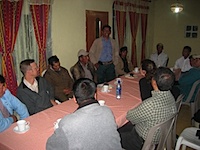 Emily called our village when we were close to Santa Eualia, so they could send a local microbus out to meet us and transfer the computers. We arrived just after nightfall, and were suprised to find that a TON of elders came along for the ride. They took us and our Peace Corps companions out to dinner to celebrate this momentous occasion. In true Guatemalan fashion, many speeches were made and many thanks were given. Here we listen to Don Tomax, the COCODE (head of municipal developement). I must say, I was moved and touched by some of the things they said, and the fact that these nice old men came all the way out to meet us on a night that I THOUGHT was just basically a moving party. Emily called our village when we were close to Santa Eualia, so they could send a local microbus out to meet us and transfer the computers. We arrived just after nightfall, and were suprised to find that a TON of elders came along for the ride. They took us and our Peace Corps companions out to dinner to celebrate this momentous occasion. In true Guatemalan fashion, many speeches were made and many thanks were given. Here we listen to Don Tomax, the COCODE (head of municipal developement). I must say, I was moved and touched by some of the things they said, and the fact that these nice old men came all the way out to meet us on a night that I THOUGHT was just basically a moving party.
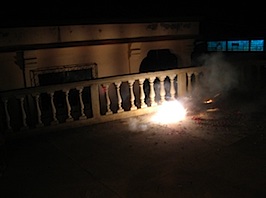 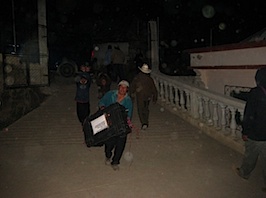
We then piled us and the computers into a microbus with all the seats removed and headed home. A short trip later, we arrived in town to the typical greeting of fireworks and excited people. Some of the jovenes (youngsters) that are interested in helping me run the center carried the boxes from the microbus to the room we’re going to use in the Health Center.
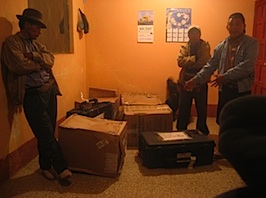 As you can see, some of the cartons are in pretty sorry shape after moving by car, then airplane, then van, then pickup, then handtruck, then jeep. It will be interesting to see how many computers survived. The stuff in the pelican cases fared better, and I opened one of them to show the villagers what some of the gear looks like. After that, most people went home to sleep, but a few of the leaders hung around for an impromptu meeting. It happened in Q’anjob’al, but with a little help from Lucas I was able to get the gist of what was going on. They were discussing how to handle the participation problem: some of the villagers don’t think the project is worthwhile or don’t “get it”, yet the town as a whole has to raise money to get a separate power meter and wire the room for extra outlets. You see, they put this off until they actually saw hard evidence that the computers would really arrive. That lack of faith is understandable, after all they’ve been through with their government’s disinterest in their wellbeing and the civil war in the recent past. It doesn’t offend me at all. I left, confident they’d figure it out and glad that THAT end of the work is their problem, not mine. As you can see, some of the cartons are in pretty sorry shape after moving by car, then airplane, then van, then pickup, then handtruck, then jeep. It will be interesting to see how many computers survived. The stuff in the pelican cases fared better, and I opened one of them to show the villagers what some of the gear looks like. After that, most people went home to sleep, but a few of the leaders hung around for an impromptu meeting. It happened in Q’anjob’al, but with a little help from Lucas I was able to get the gist of what was going on. They were discussing how to handle the participation problem: some of the villagers don’t think the project is worthwhile or don’t “get it”, yet the town as a whole has to raise money to get a separate power meter and wire the room for extra outlets. You see, they put this off until they actually saw hard evidence that the computers would really arrive. That lack of faith is understandable, after all they’ve been through with their government’s disinterest in their wellbeing and the civil war in the recent past. It doesn’t offend me at all. I left, confident they’d figure it out and glad that THAT end of the work is their problem, not mine.
Next week: damage assessment, and figuring out how to make Ubuntu work for me and my village.
Posted by: jfanjoy
Friday, April 17th, 2009 at 9:44 am
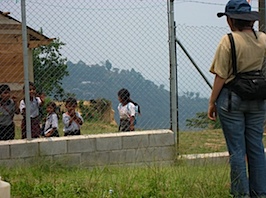 We’ve talked about Quixabaj before- it’s the third Health Post we work at. It’s so far away and hard to get to that we only go there for a few days every two months, and frankly, we can’t really get much done. We feel bad about this, and have been petitioning our boss at the Peace Corps to place a volunteer there when the next training group graduates in August. The people of Quixabaj deserve it; on one hand, they’re wracked with terrible poverty and there is a MOUNTIAIN of potential development work to be done; and on the other hand, they have a good work ethic and the leaders are willing to collaborate with Peace Corps volunteers. It’s a perfect opportunity. Emily and I, however, can’t give them the support they need. Since we don’t live there, we have to spend and entire day’s travel to get there, a day to get back, and while we’re there we don’t have the same community relationship as in our village. We’ve talked about Quixabaj before- it’s the third Health Post we work at. It’s so far away and hard to get to that we only go there for a few days every two months, and frankly, we can’t really get much done. We feel bad about this, and have been petitioning our boss at the Peace Corps to place a volunteer there when the next training group graduates in August. The people of Quixabaj deserve it; on one hand, they’re wracked with terrible poverty and there is a MOUNTIAIN of potential development work to be done; and on the other hand, they have a good work ethic and the leaders are willing to collaborate with Peace Corps volunteers. It’s a perfect opportunity. Emily and I, however, can’t give them the support they need. Since we don’t live there, we have to spend and entire day’s travel to get there, a day to get back, and while we’re there we don’t have the same community relationship as in our village.
Our wishes were granted this week. Basilio (our boss) and Makali (the security chief at Peace Corps Guatemala) drove all the way out here to see Quixabaj, meet the village leaders, and evaluate it as a future site. It’s a big committment for both the town and the Peace Corps, so they wanted to do it right. They invited Emily and I along, since we are the face of Peace Corps in this region. They also invited several native Q’anjob’al speakers. Aurelio, our counterpart form the Ministry of Health, came to help with translation because it was he who officially invited the Peace Corps. Manuel Jesus and Don Tomax, two of the leaders from our village, came to tell the leaders of Quixabaj about how great a deal it is to have the Peace Corps in your town. Manuel and Tomax are interested in helping their fellow village (the Q’anjob’al Mayans are a very socially conscious people), but I also have this amusing suspicion that they want Quixabaj to have their own volunteers so that we can do more work in our own village. Heh.
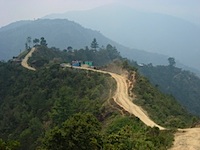 We all piled into two Peace Corps jeeps and made an early start. The weather was great, and the trip only takes two hours in a private jeep (as opposed to four while riding in the back of a 4×4 with 20 Guatemalans). Basilio and Makali got to really appreciate how tough a journey it is, though Makali pointed out that from a security standpoint, he was not too concerned about that. If a volunteer breaks a leg or something in a really remote place, the locals are usually good about throwing you on a horse or something and getting you out. Sounds pretty Indiana Jones, but it’s true: our villagers would to whatever had to be done to take care of us, and I am certain that the Quixabaj folks would do the same. We all piled into two Peace Corps jeeps and made an early start. The weather was great, and the trip only takes two hours in a private jeep (as opposed to four while riding in the back of a 4×4 with 20 Guatemalans). Basilio and Makali got to really appreciate how tough a journey it is, though Makali pointed out that from a security standpoint, he was not too concerned about that. If a volunteer breaks a leg or something in a really remote place, the locals are usually good about throwing you on a horse or something and getting you out. Sounds pretty Indiana Jones, but it’s true: our villagers would to whatever had to be done to take care of us, and I am certain that the Quixabaj folks would do the same.
Once we arrived, we met with the village leaders in the lobby of the Health Center. Basilio has this uncanny ability to immediately engage and beguile Guatemalans. Part is his voice, but part is some odd mental power. He started the meeting out pretty aggressively, in a way only he could get away with.
“So,” he began. “Why is there only one woman here?”
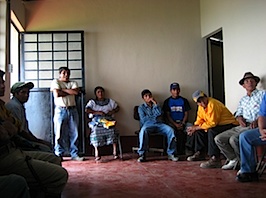 
The leaders hummed and hawed a bit, but the point was made. Peace Corps is about change. He then segued into other things: what are the biggest concerns the leaders have about Quixabaj, what aid have they received in the past, how would the people react to having gringoes living amongst them. Don Tomax and Manuel gave testimonials about how much they like having their volunteers. Emily got up and reminded the Quixabaj elders that they won’t be losing our support, and we will still be available to advise a permanent volunteer should they get one. The meeting went on for about an hour, but by the end, everyone felt pretty optimistic about a long-term arrangement.
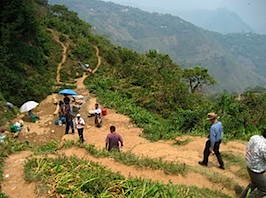 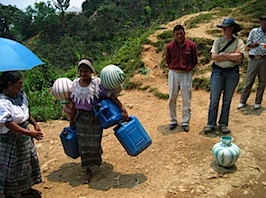
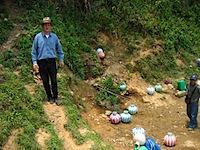 We then broke, with some of us staying in the health center to hash out details, others going down the mountain to see the town’s spring. Of the many problems they have on their plate, water is probably the biggest issue in Quixabaj. This spring shown here puts out a little less than a gallon per minute (click on the picture to the right to see a closeup of Makali and the spring), and serves a third of the town. Several hundred people. Women start lining up at 2am to fill their jugs, then haul them back up hill to their houses. A girl with jugs showed up when we were standing around talking about ideas to improve the situation, and I took her picture. Without asking. That’s a no-no and I know better, but I just forgot. Luckily, there was a lingering sense of excitement about our presence, and nothing came of it. We then broke, with some of us staying in the health center to hash out details, others going down the mountain to see the town’s spring. Of the many problems they have on their plate, water is probably the biggest issue in Quixabaj. This spring shown here puts out a little less than a gallon per minute (click on the picture to the right to see a closeup of Makali and the spring), and serves a third of the town. Several hundred people. Women start lining up at 2am to fill their jugs, then haul them back up hill to their houses. A girl with jugs showed up when we were standing around talking about ideas to improve the situation, and I took her picture. Without asking. That’s a no-no and I know better, but I just forgot. Luckily, there was a lingering sense of excitement about our presence, and nothing came of it.
On the trip back, we discussed the meeting. Much to my relief, Basilio and Makali agree: this site is a winner, and definately worth making into a Peace Corps post. But he popped a suprise on me: in breaking with a long-standing tradition, he wants to place TWO volunteers in the site! It makes sense; it is very remote, they will likely need that kind of support network, and there is more than enough work to keep two people busy. Also, the new Quixabaj volunteers will have to be selected carefully. To that end, Basilio wants Emily and I to do a presentation to the new trainees in June and interview any volunteers. Then, when they start in August, we are to accompany them to Quixabaj and help them for the first week or so to make sure they integrate smoothly. Whoever these two adventurous people are, they are definitely going to get the “60s Peace Corps experience”, maybe even more than Emily and I did. Should be exciting.
Posted by: jfanjoy
Thursday, April 16th, 2009 at 11:50 pm
With a title like that, you KNOW this post should be cool.
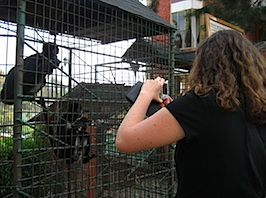
We had our Regional Security Meeting yesterday. It happens once a year or so, and all thirty or so PCVs that work in the department of Huehuetenango get together with the security director to talk about what we’re supposed to do in an emergency. Being a US Federal Agency, the Peace Corps is pretty into the whole “emergency preparedness” thing. I am not allowed to go into much detail in the blog, but suffice it to say that we are well looked-after should there be a massive earthquake/ hurricane/ civil disturbance/ nuclear war in Guatemala. Though, I was somewhat disappointed to find out that they actually DON’T have gatling-gun-toting blackhawk helicopters on standby with a team of commandos to extract us from our sites. It’s like someone telling you Santa Claus doesn’t exist.
What does this have to do with monkeys, you ask? Well, the hotel that hosts our meetings has a tiny private ZOO attached to it, of all things. How random. The star attraction is a pair of monkeys. I emailed my friend Darren, who is a primatologist, to ask him what kind they are and I will let you know what he tells me. [update: he says they are spider monkeys, the smallest and most social of the new world primates.] While I was “talking” to one of the monkeys, I felt something caress my face, and was startled to see that she’d sneaked her tail out of the cage and past my perhipheral vision, just to touch me. I had to laugh; I got tricked by a monkey! I could see her hands and feet the whole time, but I forgot about the prehensile tail. Oh, and the big pink monkey outside of the cage is Emily.
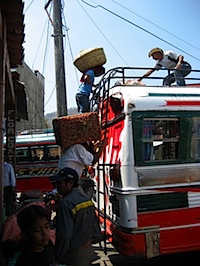 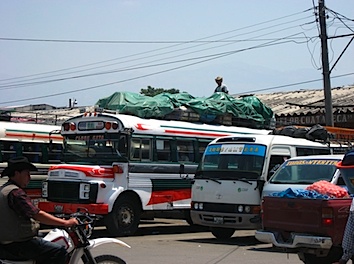
On our way back to our site, I was waiting to get onto the bus and saw the ayudantes running up and down the ladders of the bus, loading cargo. Those guys work HARD. And who’d have ever thought a school bus could carry so much stuff? I had to take a picture. It’s like an ant carrying a giant chunk of bread. And the best part? I posted a video of it on YouTube so you can enjoy the full effect.
Posted by: jfanjoy
Wednesday, April 15th, 2009 at 7:22 am
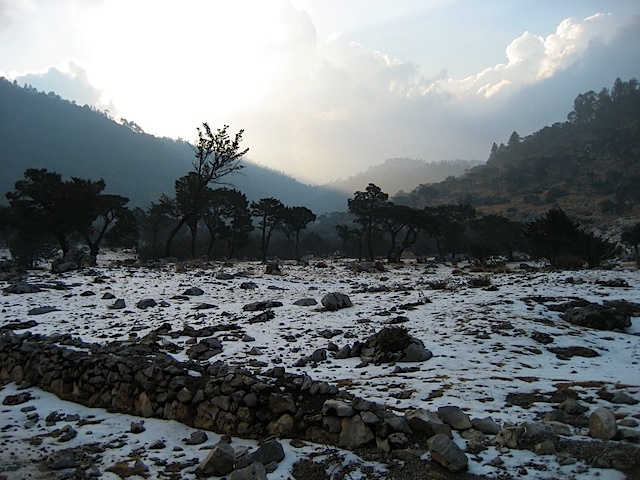
The Cumbre is a region of Guatemala that is a high, dry plateau. By high, I mean between 10,000 and 12,000 feet above sea level. It can get pretty cold, but is absolutely beautiful and we love traveling through it. Since it is the major geographic feature that separates our site from Huehuetanango, the departmental capitol, we pass through a few times a month depending on how busy we are.
We were driving across the Cumbre yesterday to go to a meeting, and when we rounded a bend, I remarked on how strangely the late afternoon light fell on the rocks ahead. It almost made it look like snow. “That’s granizo”, my boss said. Hail! We stopped the car, and everyone got out to take pictures. I made a snowball out of it, and bashed it against the other car in our caravan. If you click on the picture above, it will come up in a high-res version you can use for a desktop.
Posted by: jfanjoy
Wednesday, April 8th, 2009 at 10:31 pm
 I’m a do-it-yourself kindof guy, and Emily really likes fresh food. Put these two together, and it’s time for a garden. But in this cold weather, not just ANY sort of garden will do. We need a greenhouse! So, I spoke to my dad (himself a gardener) and he decided to fund a project. For a little under $100, we built a 30′ x 12′ community experimental greenhouse. The idea with this project is that we are going to grow vegetables that don’t normally grow this far up, to show the locals that it can be done. Since we’re funding it, we take all the risk if it fails, but they reap the rewards (in educational terms) if it succeeds. We’re focusing on plants that will help round out their nutrition, giving them vitamins and minerals that they don’t get in their corn-and-beans diet: spinache, green beans, peas, tomatoes, peppers. We’re also growing a few things just for “wow”: cantaloupe, watermelon, pumpkin. Oh, and I wanted a few cucumbers, so they are in there as well. I’m a do-it-yourself kindof guy, and Emily really likes fresh food. Put these two together, and it’s time for a garden. But in this cold weather, not just ANY sort of garden will do. We need a greenhouse! So, I spoke to my dad (himself a gardener) and he decided to fund a project. For a little under $100, we built a 30′ x 12′ community experimental greenhouse. The idea with this project is that we are going to grow vegetables that don’t normally grow this far up, to show the locals that it can be done. Since we’re funding it, we take all the risk if it fails, but they reap the rewards (in educational terms) if it succeeds. We’re focusing on plants that will help round out their nutrition, giving them vitamins and minerals that they don’t get in their corn-and-beans diet: spinache, green beans, peas, tomatoes, peppers. We’re also growing a few things just for “wow”: cantaloupe, watermelon, pumpkin. Oh, and I wanted a few cucumbers, so they are in there as well.

I mentioned my idea to Nas Palas, who owns all of the arable land around our house. He was keen on the plan, and gave us free reign to use as much space as we needed. Using a hoe, I turned up tons of black, rich soil. Then I carted six wheelbarrels full of sheep poop down to the site, and mixed that in with the dirt to make the perfect planting mix. If you click on the picture to the left, you can see the neighbors’ chickens helping me work.
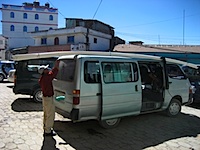
After talking to a few other Peace Corps volunteers about the cheapest way to build the greenhouse, I went to town for materials. The 1/2″ PVC tubes were easy to get, but I had to scour Santa Eulalia before I found anyone selling CLEAR nylon. Lots of black and blue (for fixing roof leaks??), but only one place with clear. And it was kindof expensive. Once we had all the goodies, we carted them through town and loaded them onto the waiting microbus. We’re buddies with most of the drivers, and they know us personally, but we got unlucky this time and the driver was the one jerky dude that always overcharges us. Aah, Guatemala. He took double fares from us and tied the goods to the roof.
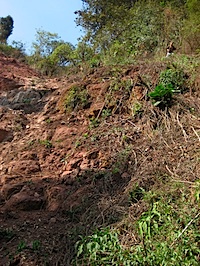 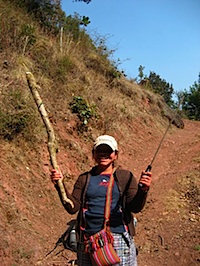 
The next day we went into the woods to collect wooden stakes. We spend a lot of time telling the locals it’s a bad idea to cut down all the trees, so we went to a place I know where there are still fallen timbers from a landslide last fall. We took some of our local friends with us, which turned out to be a good idea since they are pretty handy with the machete. I climbed up the cliff (that’s me, in the top right corner of the picture), cut limbs with my machete, then threw them down into the valley where Emily and the girls were waiting. Then, Elisea cut them to size with her machete. Once we had a big load of stakes, I carried them out Guate-style with a rope. Sadly, this was the hottest day we’ve had all year, and it was a fair amount of work. Time elapsed: 4 hours.
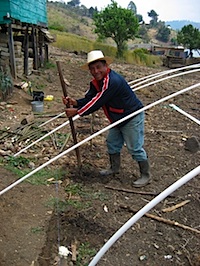 The day after that, Nas Palas came by. “Those stakes you cut will never work,” he explained. “They’re too soft, and will rot in a month. Let me get you some better ones.” He grabbed his machete and took off up the hill. Before I understood what was happening, he was back with a HUGE rick of hardwood stakes two inches in diameter. I noticed that they each had been cut through with a single swing of his machete, too. Yikes. The lesson here is that I just can’t compete with the locals in a lot if things, and that it’s always good to listen to their advice on this kind of stuff. Time elapsed: 10 minutes. The day after that, Nas Palas came by. “Those stakes you cut will never work,” he explained. “They’re too soft, and will rot in a month. Let me get you some better ones.” He grabbed his machete and took off up the hill. Before I understood what was happening, he was back with a HUGE rick of hardwood stakes two inches in diameter. I noticed that they each had been cut through with a single swing of his machete, too. Yikes. The lesson here is that I just can’t compete with the locals in a lot if things, and that it’s always good to listen to their advice on this kind of stuff. Time elapsed: 10 minutes.
Nas then helped us put in the stakes. He had a trick method for this too, that involved a wicked-looking pole with a steel tip that you stab repeatedly into the ground until you have a posthole of sorts. I was tickled to see that the greenhouse was now becoming a community project!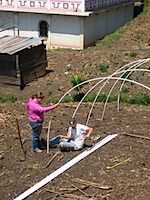 Once the stakes were in, we wired the PVC tubes to the stakes, creating giant hoops. Our friend Cat was visiting us, so she helped with that part. That’s her in the crazy pink sweater. Once the stakes were in, we wired the PVC tubes to the stakes, creating giant hoops. Our friend Cat was visiting us, so she helped with that part. That’s her in the crazy pink sweater.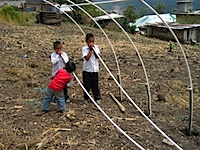 After installing the 11 hoops, we used the remaining tubes as lateral supports to stiffen the structure. That is, after the kids were done using them as trumpets. When we were about halfway through, the kids who had been watching us from the corners and rooftops couldn’t resist any longer and came over to see what the heck we were up to. Soon, they wanted to help, and got in on the act as well. After installing the 11 hoops, we used the remaining tubes as lateral supports to stiffen the structure. That is, after the kids were done using them as trumpets. When we were about halfway through, the kids who had been watching us from the corners and rooftops couldn’t resist any longer and came over to see what the heck we were up to. Soon, they wanted to help, and got in on the act as well.
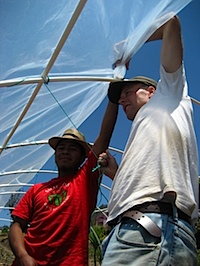 Lucas, one of our friends in town, wandered over to take a pause from his own agricultural pursuits. He helped us spread the plastic over the frame as he quizzed me about the structure: What would we plant? How much did it cost? He is one of the more forward-looking people in the village, since he spent about 5 years working in the states and has a more worldly view on how things are, and how they could be. Lucas, one of our friends in town, wandered over to take a pause from his own agricultural pursuits. He helped us spread the plastic over the frame as he quizzed me about the structure: What would we plant? How much did it cost? He is one of the more forward-looking people in the village, since he spent about 5 years working in the states and has a more worldly view on how things are, and how they could be.

After we took a break for lunch, it was time to start sewing the covering down so it wouldn’t end up in the bottom of the valley with the first strong wind. Our buddy Chalio is ALWAYS helpful, and can be seen here helping Emily sew the nylon onto the structure. The third day, our friend and Q’anjob’al teacher Pedro came by. None of us really felt like language class, so we took it outside and worked on finishing up the greenhouse. We made ourselves feel better by practicing related words like mitx’ q’ab’ (hand 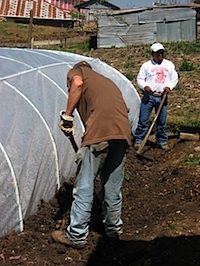 tools) and so forth. He was pretty excited about the project, as he has a similar greenhouse for growing mushrooms (except the plastic is black) and wants to do a clear one for vegetables in the near future. Pedro is just plain helpful all the time. He is also a farmer with lots of experience, and he gave us good input on what we should grow: no point in growing radishes, as they are cold-climate veggies and could just be grown outside. No point in growing a lot of cucumber, because people here aren’t interested in them. He was really enthusiastic about the watermelon and tomatoes, though, so we went heavy on those. tools) and so forth. He was pretty excited about the project, as he has a similar greenhouse for growing mushrooms (except the plastic is black) and wants to do a clear one for vegetables in the near future. Pedro is just plain helpful all the time. He is also a farmer with lots of experience, and he gave us good input on what we should grow: no point in growing radishes, as they are cold-climate veggies and could just be grown outside. No point in growing a lot of cucumber, because people here aren’t interested in them. He was really enthusiastic about the watermelon and tomatoes, though, so we went heavy on those.
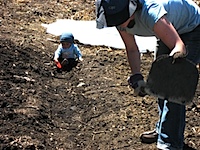 Pedro left around lunchtime, leaving us to do the finishing-up ourselves. All that remained was to hoe the mounds and rows, plant the seeds, and water it. But a last-minute helper showed up, baby Delmi, and she “helped” Emily by moving some dirt around. Eventually, Delmi’s mom showed up to reclaim her, so we let the chickens into the greenhouse instead. They were actually more helpful than Delmi, as they pounced on any grubs we turned up as we tilled. We got done just about the time the sun hit the horizon. Pedro left around lunchtime, leaving us to do the finishing-up ourselves. All that remained was to hoe the mounds and rows, plant the seeds, and water it. But a last-minute helper showed up, baby Delmi, and she “helped” Emily by moving some dirt around. Eventually, Delmi’s mom showed up to reclaim her, so we let the chickens into the greenhouse instead. They were actually more helpful than Delmi, as they pounced on any grubs we turned up as we tilled. We got done just about the time the sun hit the horizon.
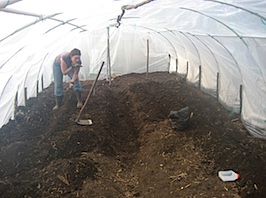 So that is how we made our greenhouse. After we finished it, I realized that it is a good project for lots of other reasons: it draws the town into being involved, and it’s VISIBLE. In our 11 months in Guatemala, it’s the first project we’ve done that has a tangible result that the people can see with their own eyes. So that is how we made our greenhouse. After we finished it, I realized that it is a good project for lots of other reasons: it draws the town into being involved, and it’s VISIBLE. In our 11 months in Guatemala, it’s the first project we’ve done that has a tangible result that the people can see with their own eyes. 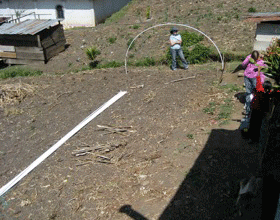
Posted by: jfanjoy
Monday, April 6th, 2009 at 12:59 pm
Joe Busch, a friend of ours and fellow Peace Corps volunteer, just put a short video on YouTube that you should check out. It explains our work in the Rural Home Preventive Health program here in Guatemala. He’s a good videographer, and he spent a fair bit of time on it, so get with the clicking right here. That’s Joe and his wife Katy narrating.
Emily and I appear in the video only briefly, in part because they shot much of the footage during a day of training that we skipped to help with medical translation. But you can see me giving a lecture to some health workers at 2:29 and Emily doing the same in El Quiché at 2:33. Also, they did a version in Spanish and you can see it here. Our bosses Ana Isabel and Basilio Estrada are narrating, and you can see what they look like at 1:57. It’s worth viewing just to hear their cool voices.
Posted by: jfanjoy
|
|
|
 Great news! We’ve had our first success with chickens. Since all the neighborhood chickens are free-range, we had to take steps against our new chickens deciding to join a diffferent flock. Following our neighbors’ advice, during the day we tied our chickens to a stake near their coop with a 20′ string around their leg. At night, we locked them in the coop with some food and water. The idea is that after a week, the chickens forget that they ever lived anywhere else. Today was the big test: in the morning, I opend the coop door and watched them streak out of there and disappear into the horizon. I felt kindof like I’d been tricked. This evening, Emily and I waited patiently for their return. OK, that’s a lie. I harrassed Emily to go find them, and Lina told her that it was pointless and we just had to wait.
Great news! We’ve had our first success with chickens. Since all the neighborhood chickens are free-range, we had to take steps against our new chickens deciding to join a diffferent flock. Following our neighbors’ advice, during the day we tied our chickens to a stake near their coop with a 20′ string around their leg. At night, we locked them in the coop with some food and water. The idea is that after a week, the chickens forget that they ever lived anywhere else. Today was the big test: in the morning, I opend the coop door and watched them streak out of there and disappear into the horizon. I felt kindof like I’d been tricked. This evening, Emily and I waited patiently for their return. OK, that’s a lie. I harrassed Emily to go find them, and Lina told her that it was pointless and we just had to wait.















 I’m a do-it-yourself kindof guy, and Emily really likes fresh food. Put these two together, and it’s time for a garden. But in this cold weather, not just ANY sort of garden will do. We need a greenhouse! So, I spoke to my dad (himself a gardener) and he decided to fund a project. For a little under $100, we built a 30′ x 12′ community experimental greenhouse. The idea with this project is that we are going to grow vegetables that don’t normally grow this far up, to show the locals that it can be done. Since we’re funding it, we take all the risk if it fails, but they reap the rewards (in educational terms) if it succeeds. We’re focusing on plants that will help round out their nutrition, giving them vitamins and minerals that they don’t get in their corn-and-beans diet: spinache, green beans, peas, tomatoes, peppers. We’re also growing a few things just for “wow”: cantaloupe, watermelon, pumpkin. Oh, and I wanted a few cucumbers, so they are in there as well.
I’m a do-it-yourself kindof guy, and Emily really likes fresh food. Put these two together, and it’s time for a garden. But in this cold weather, not just ANY sort of garden will do. We need a greenhouse! So, I spoke to my dad (himself a gardener) and he decided to fund a project. For a little under $100, we built a 30′ x 12′ community experimental greenhouse. The idea with this project is that we are going to grow vegetables that don’t normally grow this far up, to show the locals that it can be done. Since we’re funding it, we take all the risk if it fails, but they reap the rewards (in educational terms) if it succeeds. We’re focusing on plants that will help round out their nutrition, giving them vitamins and minerals that they don’t get in their corn-and-beans diet: spinache, green beans, peas, tomatoes, peppers. We’re also growing a few things just for “wow”: cantaloupe, watermelon, pumpkin. Oh, and I wanted a few cucumbers, so they are in there as well. 










 Pedro left around lunchtime, leaving us to do the finishing-up ourselves. All that remained was to hoe the mounds and rows, plant the seeds, and water it. But a last-minute helper showed up, baby Delmi, and she “helped” Emily by moving some dirt around. Eventually, Delmi’s mom showed up to reclaim her, so we let the chickens into the greenhouse instead. They were actually more helpful than Delmi, as they pounced on any grubs we turned up as we tilled. We got done just about the time the sun hit the horizon.
Pedro left around lunchtime, leaving us to do the finishing-up ourselves. All that remained was to hoe the mounds and rows, plant the seeds, and water it. But a last-minute helper showed up, baby Delmi, and she “helped” Emily by moving some dirt around. Eventually, Delmi’s mom showed up to reclaim her, so we let the chickens into the greenhouse instead. They were actually more helpful than Delmi, as they pounced on any grubs we turned up as we tilled. We got done just about the time the sun hit the horizon.
